ParaView
ParaView is the world’s leading open source post-processing visualization engine. It integrates with your existing tools and workflows, allowing you to build visualizations to analyze data quickly. With its open, flexible, and intuitive user interface, you can analyze extremely large datasets interactively in 3D or programmatically using ParaView’s batch processing.
Download ParaView
ParaView 5.10+ can be downloaded from here.
Virtual Environment
ParaView comes with its own Python, which may be missing some dependencies for the desired usage. We can add more Python packages into ParaView by creating a virtual environment and then activating it inside the application using the import line import paraview.web.venv or by using our local version and importing it.
First, we need to setup the ParaView add-on python environment, in which we will only install trame, but we could add any other Python libraries that are not included in the ParaView bundle.
python3.9 -m venv .pvenv
source ./.pvenv/bin/activate
python -m pip install --upgrade pip
pip install trame trame-vtk trame-vuetify
deactivateNote:
- We can not use our virtual environment with a
vtkas ourvtklibrary will conflict with the one inside Paraview. - Since ParaView includes
vtk, any VTK example can be run with ParaView assuming the proper code is used to handle the virtual-env loading to get trame inside our Python script. - The python you use for creating your virtual-environment must match the Python version that comes with ParaView. (So far 5.10 and 5.11 use Python 3.9)
Conda environment
Conda provide many open-source packages and ParaView is part of their offering. When using the conda approach you won't need to download ParaView as it will get installed by conda for you. That way you can create a virtual-environment that can contain both ParaView and trame by doing the following.
conda create -n pv-env -c conda-forge paraview trame trame-vtk trame-vuetify
conda activate pv-envThen later you can simply use python rather than pvpython
conda activate pv-env
python .../trame-app.pyMaking trame available in ParaView
At the very top of our scripts, we need to import our helper script so the --venv path/to/venv can be processed.
import paraview.web.venv # When using downloaded ParaView from KitwareAfter that we can import trame and start using it (assuming we run our application with the --venv /path/to/venv/with/trame argument).
Running an example
The command line below illustrate how a SimpleCone example can be run on a Mac computer where ParaView 5.10 has been installed.
/Applications/ParaView-5.10.1.app/Contents/bin/pvpython \
./05_paraview/SimpleCone.py \
--venv .pvenv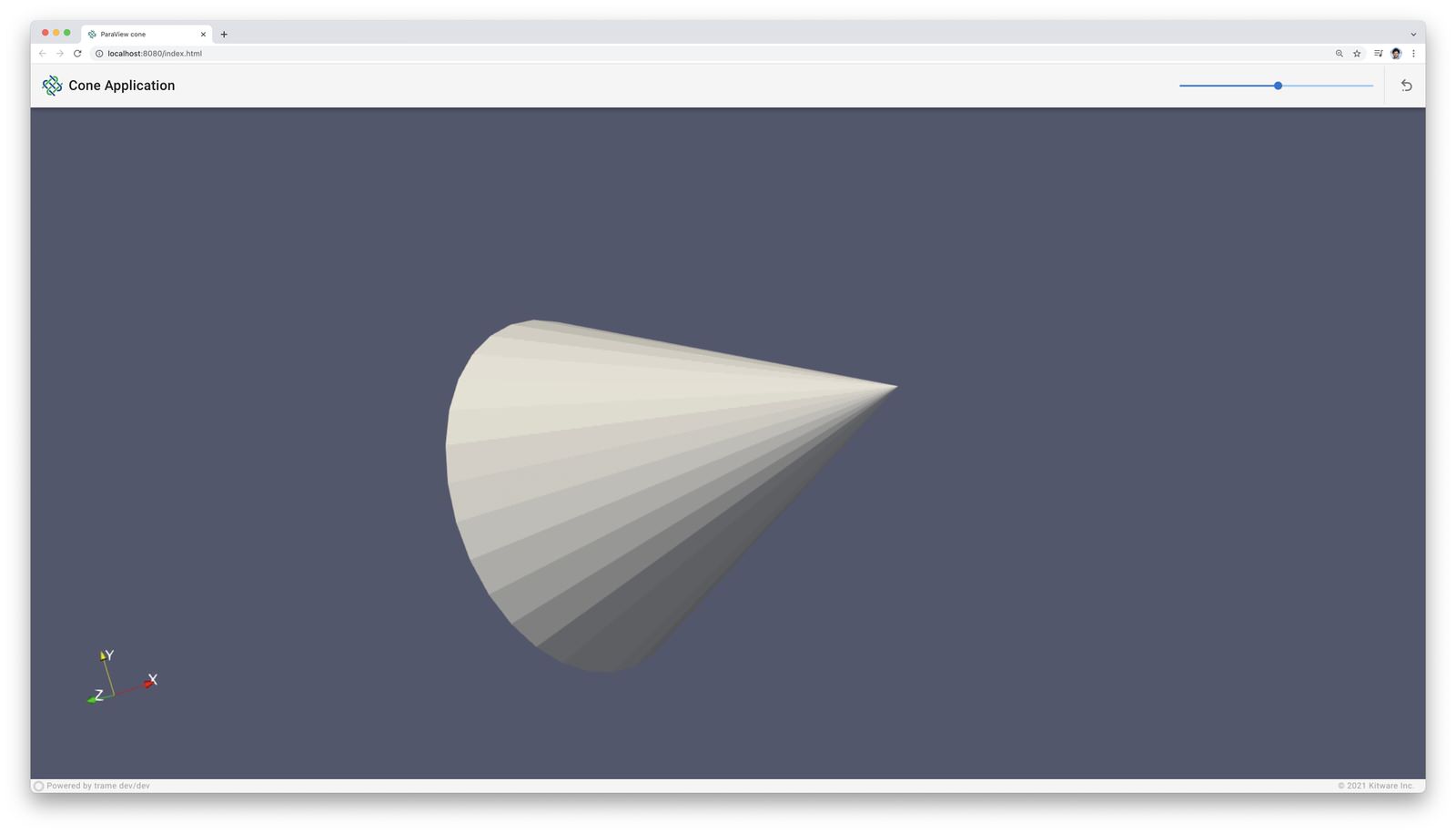
Understanding this ParaView example
ParaView use proxies which abstracts the VTK object handling so they can be easily distributed to support the processing of very large datasets.
For simplified usage, ParaView provides a simple package that lets us simply create and interact with these proxies. The SimpleCone.py example provides the core concepts needed to understand how to work with ParaView.
from paraview import simple
cone = simple.Cone() # Create a source (reader, filter...)
representation = simple.Show(cone) # Create a representation in a view (if no view, one is created)
view = simple.Render() # Ask to compute image of active view and return the corresponding viewWith these three lines, we create a full pipeline and a view. Now, we can use trame to show that view in the client.
from trame.html import vuetify, paraview
from trame.layouts import SinglePage
html_view = paraview.VtkRemoteView(view) # For remote rendering
# html_view = paraview.VtkLocalView(view) # For local rendering
layout = SinglePage("ParaView cone", on_ready=html_view.update)
with layout.content:
vuetify.VContainer(
fluid=True,
classes="pa-0 fill-height",
children=[html_view],
)The rest of the code looks very similar to the VTK Hello trame example, but instead of importing the vtk module of trame
from trame.html import vuetify, vtkwe import the paraview module
from trame.html import vuetify, paraviewGUI
Now we can start adding some UI to control some of the parameters that we want to interact with dynamically. Let's first add a slider to control the resolution of the cone. We need to create a method to react when the resolution is changed by the slider. In ParaView proxies, object parameters are simple properties that can be get or set in a transparent manner. At this point, we simply need to update the cone.Resolution and update the view to see the change.
@state.change("resolution")
def update_cone(resolution, **kwargs):
cone.Resolution = resolution
html_view.update()Now, we can extend the UI with a slider on the layout.toolbar
DEFAULT_RESOLUTION = 6
with layout.toolbar:
vuetify.VSlider(
v_model=("resolution", DEFAULT_RESOLUTION),
min=3,
max=60,
step=1,
hide_details=True,
dense=True,
)With these few lines, we have created a 3D cone, which we can adjust the resolution all leveraging ParaView.
To learn more about ParaView scripting, look into ParaView trace which let you convert your UI interaction into actual Python code that can then be reused in your application.

Advanced example
With the basics in place, we can now dive further in by using some built-in features of ParaView, such as saving and loading a state file. State files are a convenient way of capturing all the settings that were used to generate a visualization with Paraview.
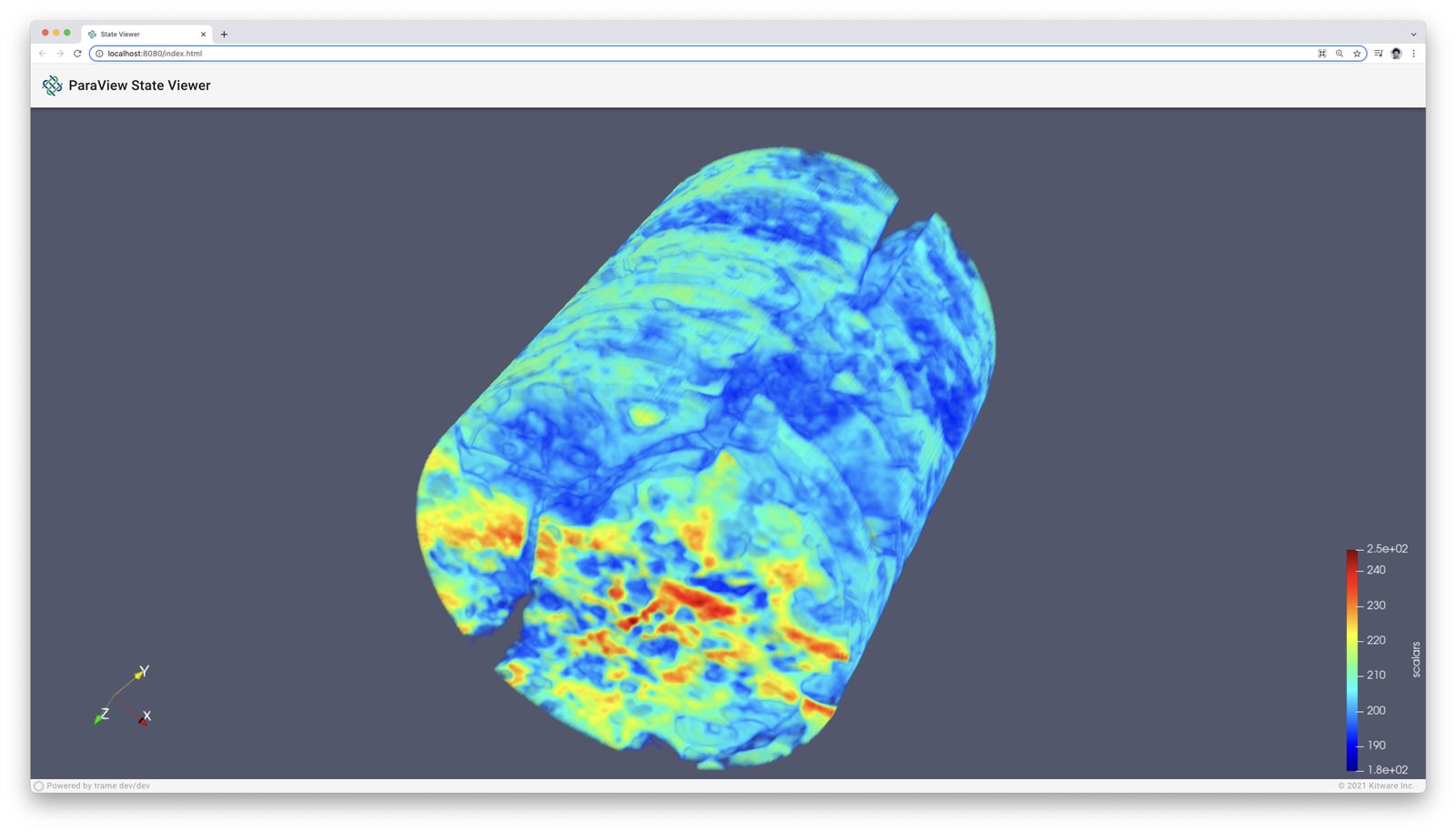
Let's analyse the example in ./05_paraview/StateLoader.py. The trame core of the example is as follows
Script Header
import venv
import os
import trame
from trame.html import vuetify, paraview
from trame.layouts import SinglePage
from paraview import simpleScript Core
The rest of the script we've seen before, but we are missing the details of the load_data function.
def load_data():
pass # I'll explain later
layout = SinglePage("State Viewer", on_ready=load_data)
layout.logo.click = "$refs.view.resetCamera()"
layout.title.set_text("ParaView State Viewer")
layout.content.add_child(vuetify.VContainer(fluid=True, classes="pa-0 fill-height"))
if __name__ == "__main__":
layout.start()load_data
The load_data() function requires us to code the follow
- Process a
--dataargument that contains the path to the file to load - Load the provided file path as a state file.
- Create a view element and connect it to the view defined in the state
- Add that view element into the content of our UI
Process CLI argument --data
The (1) is achieved with the following set of lines. More information on CLI are available here.
parser = trame.get_cli_parser()
parser.add_argument("--data", help="Path to state file", dest="data")
args, _ = parser.parse_known_args()
full_path = os.path.abspath(args.data)
working_directory = os.path.dirname(full_path)Load the state file
To achieve (2) with ParaView the following set of lines are needed. ParaView trace should be able to explain the magic using the UI and looking at the corresponding Python code.
simple.LoadState(
full_path,
data_directory=working_directory,
restrict_to_data_directory=True,
)
view = simple.GetActiveView()
view.MakeRenderWindowInteractor(True)Create and Connect a view element
Then (3) is similarly as before for VTK.
html_view = paraview.VtkRemoteView(view)Add view element to UI
Finally (4) is achieved with the following set of lines, the same way it was achieved with VTK in trame when switching from remote to local rendering.
layout.content.children[0].add_child(html_view)
layout.flush_content()That's it. You now have a ParaView trame application that let you reproduce complex visualization in a web context.
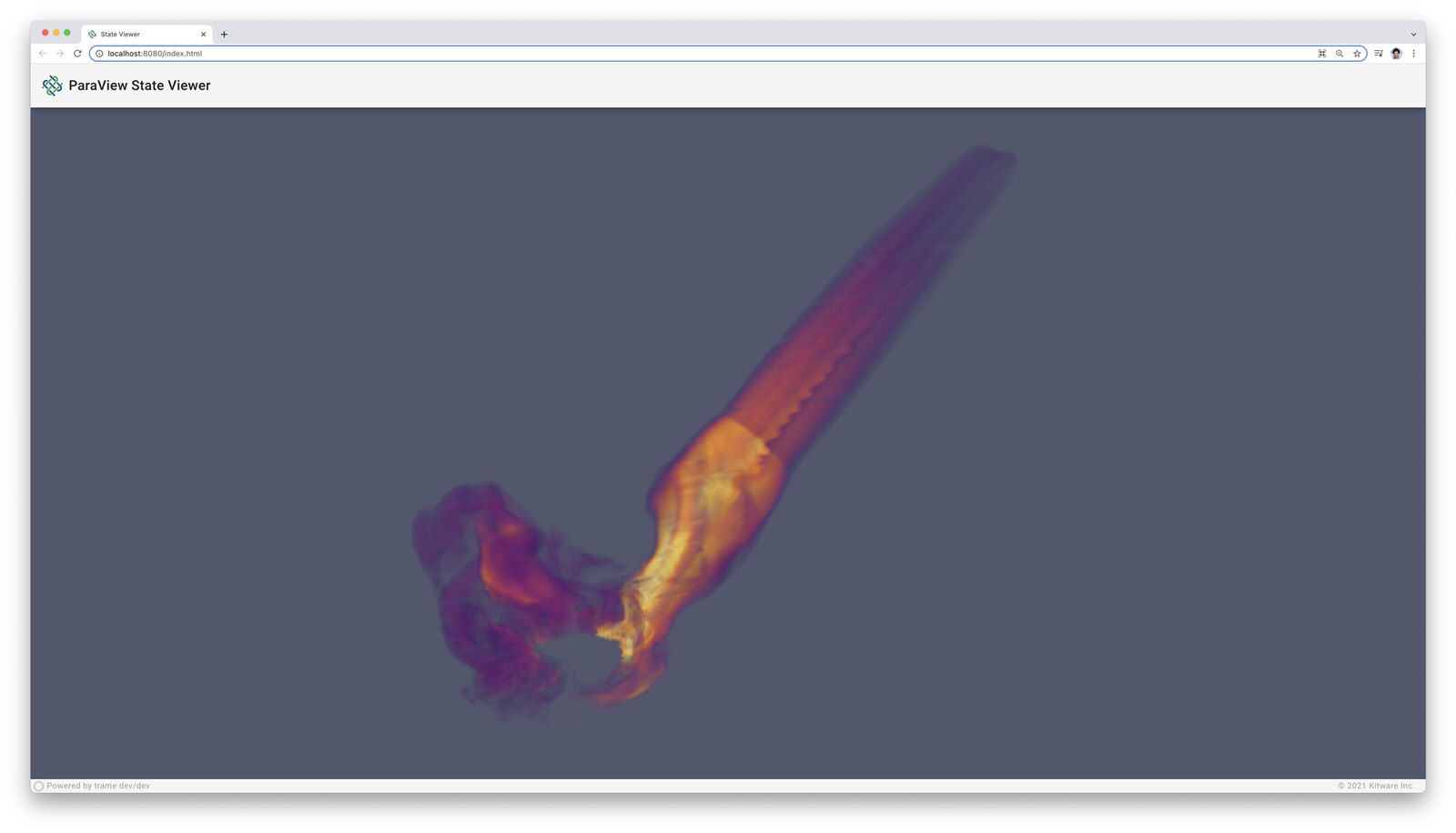 | 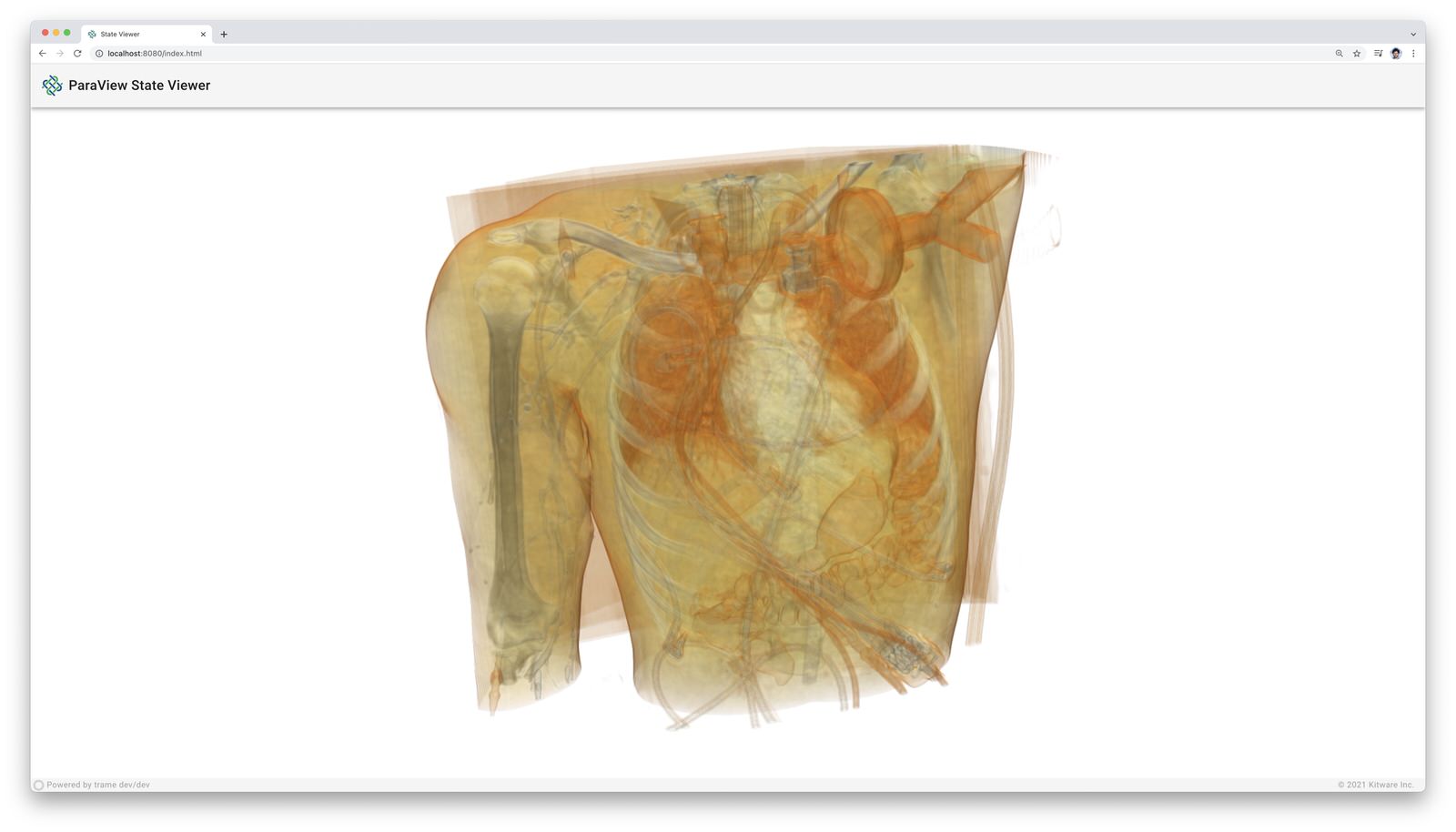 |
|---|---|
| Asteroid state | Volume rendering state |
Running the StateLoader
/Applications/ParaView-5.10.0-RC1.app/Contents/bin/pvpython \
./05_paraview/StateLoader.py \
--venv .pvenv \
--data ./data/pv-state-diskout.pvsm
# or
/Applications/ParaView-5.10.0-RC1.app/Contents/bin/pvpython \
./05_paraview/StateLoader.py \
--venv .pvenv \
--data ./data/pv-state.pvsmYour browser should open automatically to http://localhost:1234/
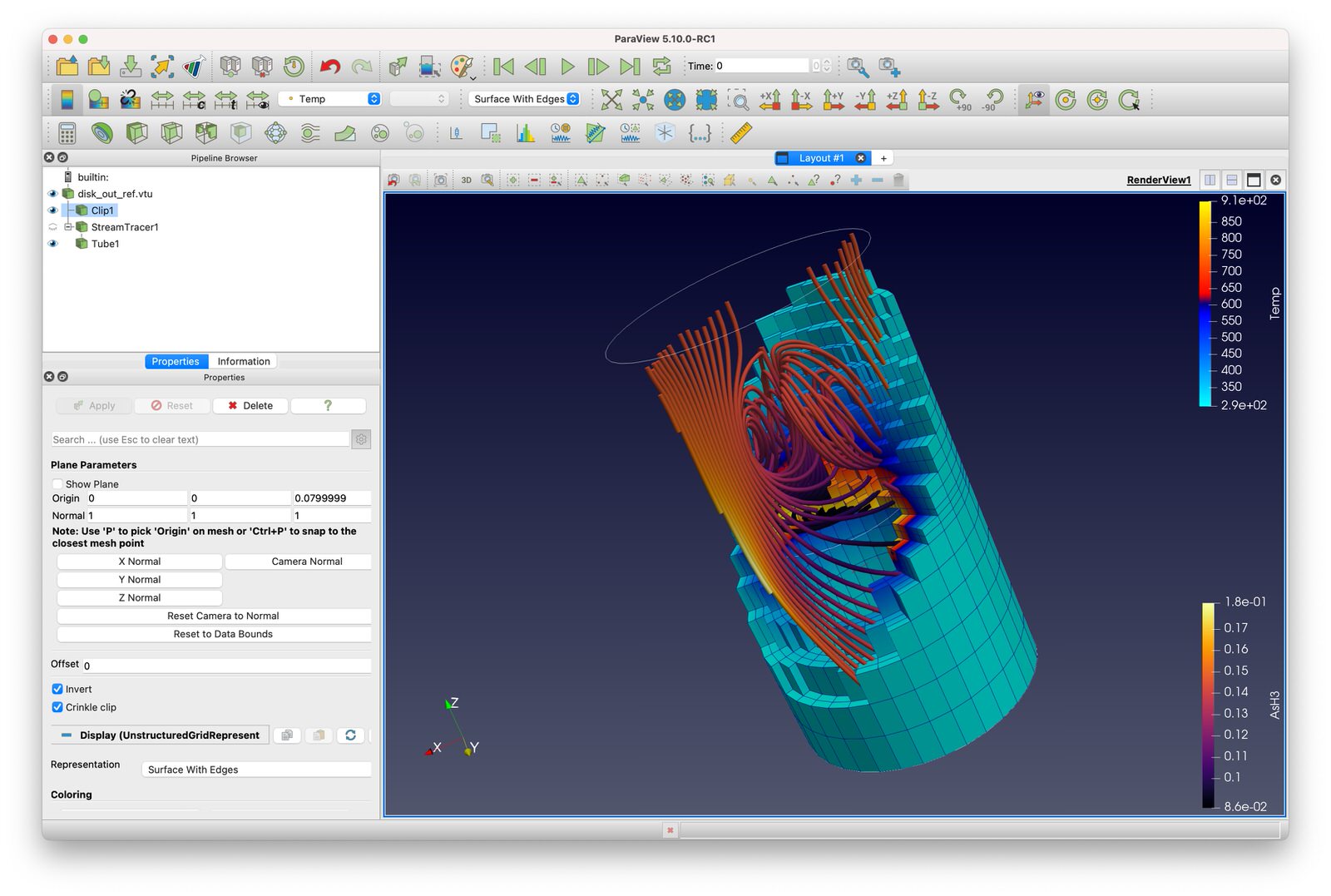 |  |
|---|---|
| ParaView | Trame viewer |
